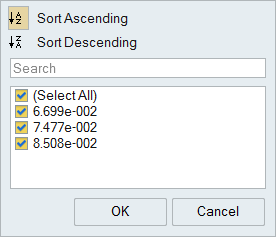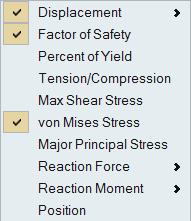Show Motion Analysis Results
Use the Show Motion Analysis Results tool to view the results of a motion part analysis in the Analysis Explorer. View and animate results, add callouts, and compare results from different runs.
- The results from the motion part analysis are consolidated into a single entity known as the Combined Motion Load Case.
- The Result Envelope shows the maximum value for each result type across the combined motion load case.
Animation Toolbar
Use the animation toolbar to play, record, and configure the animation.

Figure 1. Animation Toolbar
- Animation Settings
- Click to open the Animation Settings.
- Play and Record/Stop Recording
- Click the button to begin recording the results; the icon changes to red to indicate that it is recording. Click the icon again to stop recording.
- Start Animation/Pause Animation
- Click the button to start or pause the animation. Use the arrow buttons to jump the first or last frame in the animation.
- Move to First/Previous/Next/Last Step
- These buttons allow you to step through the animation frame-by-frame. If you hold down the Previous or Next button, it will auto-repeat. If you want to skip frames, use the Increment By feature in the Animation Settings; hold Ctrl to temporarily override this behavior.
- Slider
- Drag the slider on the toolbar to view a particular point during the analysis; use the arrow keys to move frame-by-frame through the animation.
- Current Step
- Displays the current time or frame. You can also enter a value to go to the nearest time/frame.
- List Fasteners
- Click to extract reaction forces at fasteners. This option is only avaiable for strucutral analysis.
- Make Current Frame the New Design Position
- Click to use the current position of the mechanism as the model's starting point for the next run. This option is only avaiable for motion analysis.
Animation Options
The animation options on the Analysis Explorer allow you to start and stop the animation and adjust basic settings.
| Option | Description | |
|---|---|---|
| Play/Stop Animation |  |
Animate the selected result. |
| Animation Speed | Change the speed of the animation. | |
| Scale by | Change the scale of the animation. Generally the scale of a displacement is too small to see clearly, so auto scaling is enabled by default. This option is only available for structural results, not motion results. | |
Show Options
Determine what is made visible in the modeling window when viewing analysis results. You can show or hide the initial shape, loads and supports, deformation, and/or contours.
| Option | Description | Note | |
|---|---|---|---|
| Show/Hide Initial Shape | Show/hide the initial shape as a reference. | ||
| Show/Hide All Loads and Supports | Show/hide loads and supports. You can also show only the current loads and supports. | ||
| Show/Hide Deformed State | Show/hide the deformed shape as a reference. | ||
| Show/Hide Contours | Show/hide contours. | ||
| Options |
|
||
| Show/Hide Elements | Show/hide the element edges. | This icon also appears under the view controls in the lower left of the modeling window. | |
Add Callouts to the Results
Call out and review values for a selected result type at points of interest on your model using the callout icons in the Analysis Explorer.
After running an analysis, click the Show Analysis Results icon. The Analysis Explorer appears to the right of the model.
Compare Results in a Table
Compare the results of multiple analysis runs in a table. The Compare Results button is located at the bottom of the Analysis Explorer.
For analysis, you can compare results across all runs and load cases for the selected result type. You can also compare result types at a point of interest where you have placed a callout.
Additional columns can be added to show additional result types and parameters from the Run Analysis window. The red-blue color bands correspond to the legend in the Analysis Explorer; the width of the band indicates the magnitude of the result. Changes to the upper and lower bound in the Analysis Explorer are automatically reflected in the Compare Analysis Results table.


 or
or  to select
to select 


